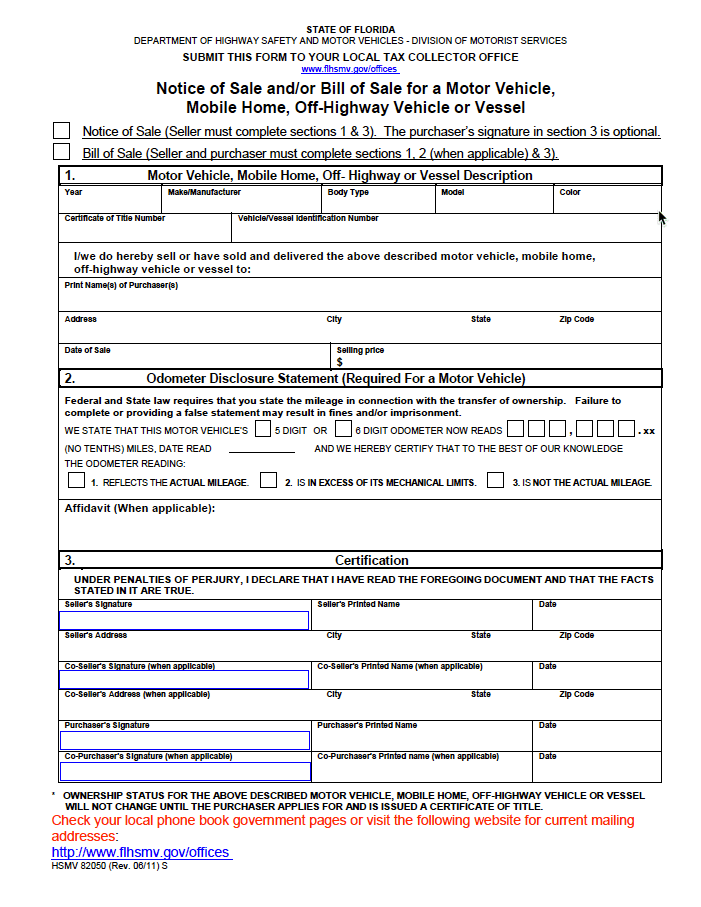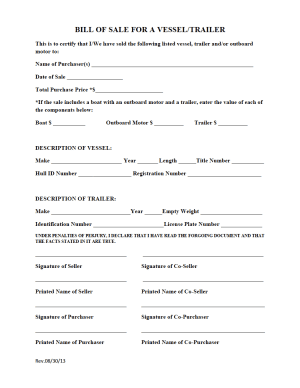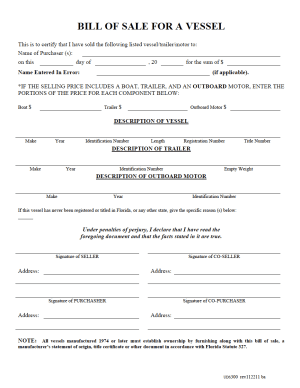Florida Boat Bill of Sale Form
A Florida boat bill of sale form provides proof of purchase and/or notice of a vessel sale. If used as a notice of sale, the seller must fill out sections one (1) and three (3). They do not need to sign, although they inscribe in section three (3) if they wish to do so. Buyers and sellers completing this document as a bill of sale must complete sections one (1) and three (3). Neither person has to fill out section two (2) as vessels do not have odometers or require a mileage reading.
|
Versions (2)
Download: PDF
Pinellas County
Download: PDF
What is a Florida Vessel Bill of Sale?
A Florida vessel bill of sale makes the transfer of a boat permanent. After the buyer and seller sign, neither person can reverse the trade unless the buyer lists it for sale. Furthermore, the document relieves the seller from responsibility as the buyer shall not expect them to pay for damages or mechanical issues that incur post-sale.
However, the previous owner has liability if they do not advise the buyer of known concerns before the sale. For example, a mechanic could diagnose the boat with a significant motor issue and recommend repairs immediately. The owner could ignore the suggestion and sell the vessel to a buyer without informing them of the diagnosis. If the motor breaks after the sale, the buyer can demand that the seller pays for the repairs.
Did You Know?Residents born on or after January 1, 1988, must complete a boating safety education course to operate a vessel of ten (10) horsepower or more. The Florida Fish and Wildlife Conservation Commission (FWC) provides the classes to interested individuals. After the student completes the course, they receive a Boating Safety Education Identification Card, which does not expire. They need to have the card on the vessel when driving it. A boat bill of sale covers the owner for ninety (90) days following the purchase. After that time, they must take and pass the education course. |
How to Register a Boat in Florida (5 Steps)
Motorized vessels operated in Florida’s public water systems require registration. Individuals have thirty (30) days after purchasing watercraft to register at a Florida Highway Safety and Motor Vehicles (FLHSMV) location. Out-of-state residents can use their boat in Florida for no more than ninety (90) consecutive days without an in-state registration. Law enforcement and the FLHSMV can ticket owners who do not provide documentation within the given time frame (§ 327.73).
Step 1 – Review Requirements
Owners must review the state’s requirements to check if their vessel requires registration. While most boats need documentation, others do not (§ 328.48). The FLHSMV does not mandate registration if the watercraft:
- Only operates in private lakes or ponds;
- Is owned by the United States government;
- Has the primary purpose of being a ship’s lifeboat;
- Is not powered and has a length of less than sixteen (16) feet;
- Is not considered a boat and is not powered (i.e., canoe, kayak, etc.).
Residents who discover an abandoned boat in Florida must follow a unique protocol. First, the original owner (if available) must hand over the title. If the individual or FLHSMV cannot locate the owner, the person who found it can obtain it.
First, they must report the item as stolen to law enforcement. Then, a detective conducts a thorough investigation and gets in touch with the owner. If the owner does not claim the boat, the person who discovered it receives a bill of sale and a write-up for title and registration.
Step 2 – Pass Inspection
This section only applies to homemade vessels.
Homemade boats under sixteen (16) feet long do not need an inspection. However, the owner must complete a title application (Form HSMV 82040) and a vessel statement of builder (Form HSMV 87002). They must send the forms to the FLHSMV with the requested payment.
Homemade boats over sixteen (16) feet long require an inspection from the FWC. The owner must submit a vessel statement of builder (Form HSMV 87002) to the inspecting officer. This person reviews the document and, upon approval, provides a certificate of inspection (Form FWC/DLE-126). The owner must send in the completed vessel statement of builder, certificate of inspection, title application, and fees to the FLHSMV when registering.
| Bring the Following: |
Step 3 – Registration
Registration for new residents or vehicles must occur at an FLHSMV office. County tax collectors and license plate agents schedule appointments for boat owners.
Individuals must ensure they have valid forms and payment available on their meeting day. For example, if the document requires notarization, the applicant must ensure it has a notary public’s stamp, seal, or signature beforehand.
Step 4 – Florida Decal + Number
After the department approves the registration and/or title request, the owner receives a registration number and decal through the mail. They must permanently display the information on their vessel so that boat patrol and other operators can easily see it.
A Florida registration number appears in the following sequence: FL-8576-IF. The owner must display it on the boat’s front left and right sections in block letters no less than three (3) inches in height. The number’s color cannot blend in with the boat’s paint.
Decals last for one (1) year at a time. It must appear on the left side of the boat either before or after the registration number. The area should not have any other stickers or text. Each year, the owner must remove the old decal and replace it with the new one.
Step 5 – Renew
Vessel registrations last for one (1) or two (2) years, depending on the owner’s selection. They must renew by the last day of their birth month. Renewals can happen online, through the mobile app, in person, or by mail up to thirty (30) days before expiration.
If renewing online, the registrar must provide their driver’s license or state identification number and pay by credit (or debit) card. Otherwise, the owner must bring or send the requested forms to the office to receive a new registration.
If the operator loses their registration or destroys it before the renewal date, they must apply for a new one using Form HSMV 87015. If they lose or destroy the title, they must submit Form HSMV 82101 and a fee ($6) to a license plate agent or a county tax collector.
| Mailing Address: |
| Florida Department of Highway Safety and Motor Vehicles Neil Kirkman Building 2900 Apalachee Parkway, MS 58 Tallahassee, FL 32399 |


